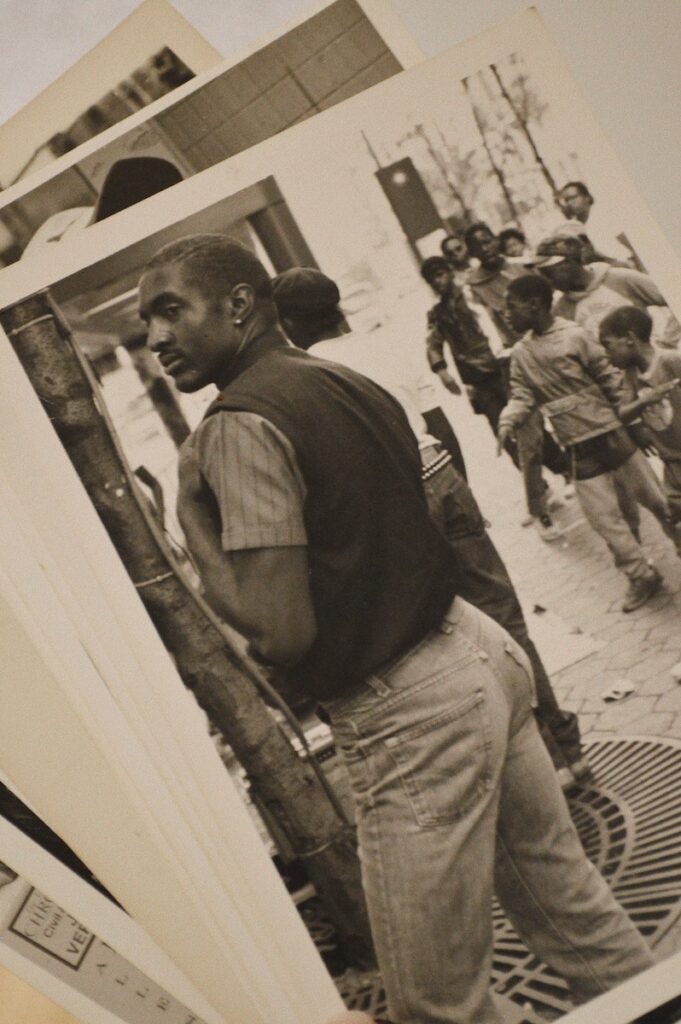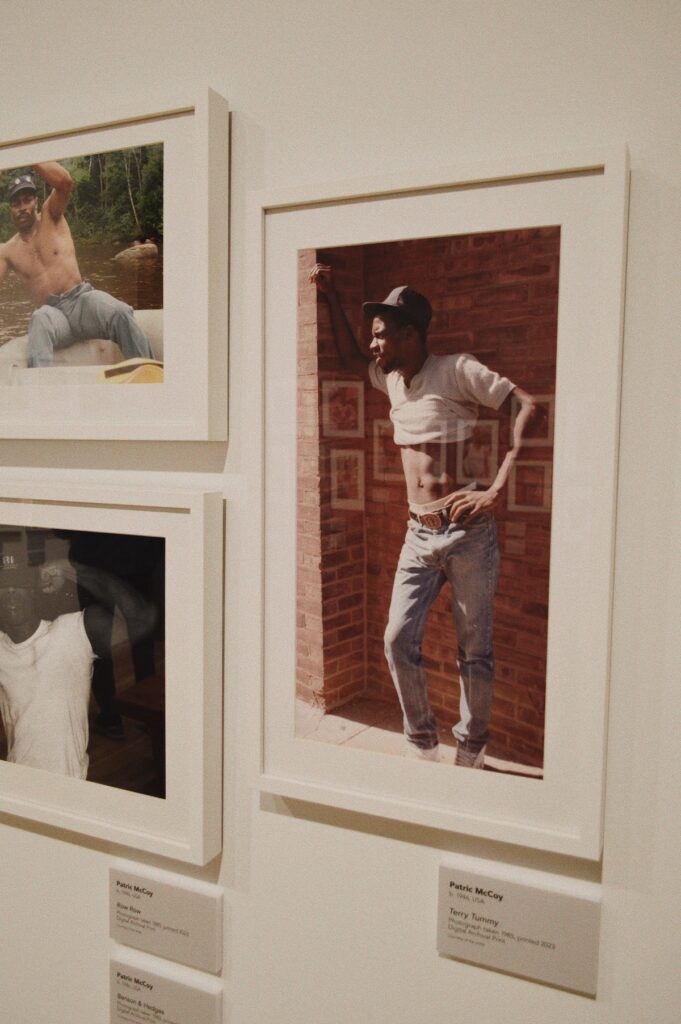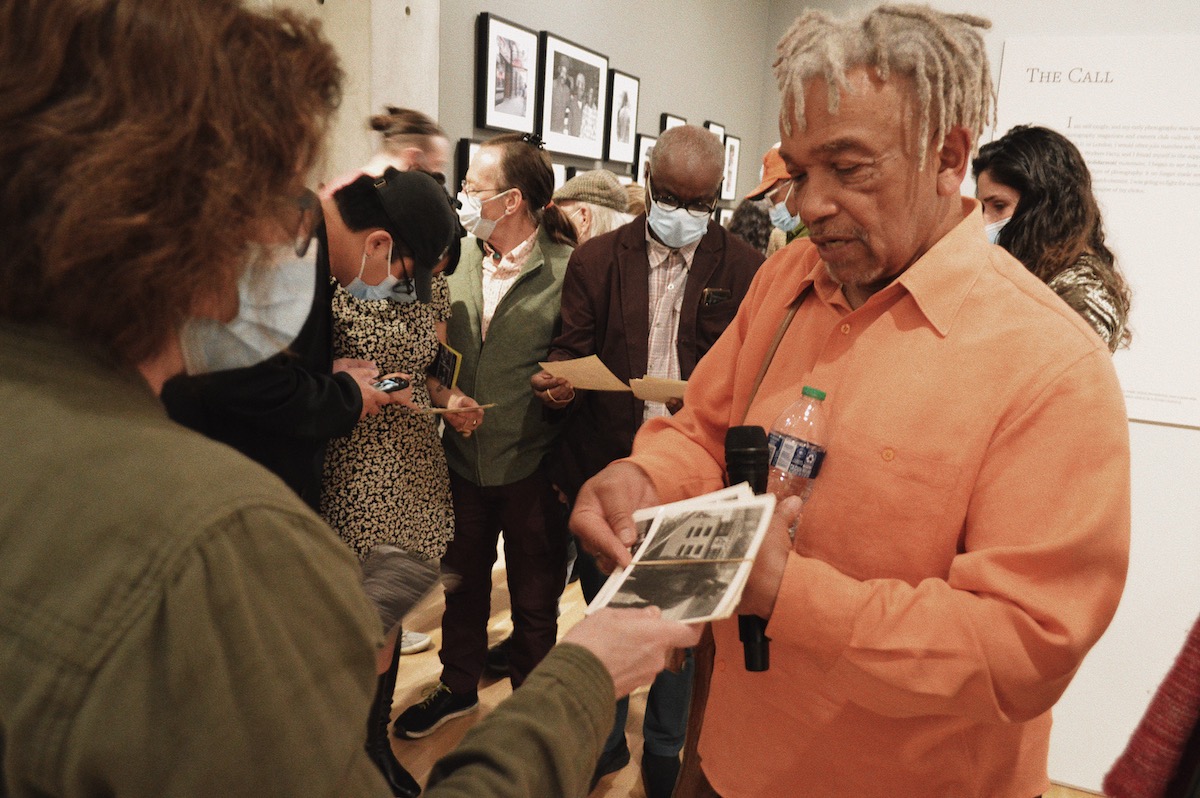Patric McCoy has spent much of his life riding his bike around Chicago—you might even spot him riding through the South Side to this day. After messing around with point and shoot cameras for years, McCoy got a proper 35mm camera in the 80s. On his 38th birthday, he made a commitment to himself that he’d take a photo everyday. He brought the camera with him on rides throughout the city, capturing those who would let him take their picture.
McCoy frequented the Rialto Tap, a haven for the Black gay men and drag queens in the 80s, until it closed to make way for Pritzker Park. He recalled the lively atmosphere of people smoking weed and drinking sixty-cent pitchers of beer—a short-lived moment in the history of the Loop, but captured through McCoy’s photography. Women would rarely let him take their picture, McCoy said, so he mostly took photos of Black gay men. He developed the images and gifted the photos to the people he encountered again, tossing the negatives in a box.
McCoy said he put his camera away at the end of the 80s because he was no longer able to ride freely without getting robbed. He moved on from photography but continued his passion for art by collecting artwork by Black artists and displaying them in his North Kenwood home. Years later, after five of his old portraits were positively received at a World AIDS Day exhibit at Alphawood Gallery, he and friend John Neff began collaborating on a book that featured dozens of his photos from the 80s. The forthcoming book is titled 38 Special in ode to the commitment he made on his 38th birthday.

On a sunny evening in early May, Wrightwood 659 gallery in Lincoln Park stayed open late to welcome longtime friends and excited attendees who had come to hear from McCoy and see Take My Picture, his first solo show. The exhibit was also a way of building momentum for the book. McCoy shared memories and his process for taking the photos—many of the men featured in the exhibit had simply shouted, “Hey take my picture!” when they saw him riding his bike. Some fifty black-and-white and color portraits are on display at Wrightwood 659 until July 15, featuring Black gay men from across the South Side.
I was grateful to have a conversation with McCoy, who generously allowed me to take his picture. This interview has been edited for length and clarity.
Congratulations on your first show, how are you feeling? And please tell me, how did you go about realizing this show?
I am exhilarated by the fact that people are paying attention and are pleased to see these works. I am getting comments from people that they want to see more. It’s exhilarating, but it is also daunting, in that I wasn’t expecting that!
I didn’t go into this activity expecting praise and so forth—I was more interested in trying to get a situation where I could start to get the book realized. This [exhibit] was just a stepping stone to that, a very good one too! I fell into it with John Neff, who is the co-author of the book we are trying to put together, 38 Special. We were asking everyone for assistance to get the backbone of the book accomplished so we could pitch it to publishers. The Alphawood Foundation said they couldn’t do any direct funding, but they could give us a show. So that is how this came about.
Are you interested in having more shows before or after the book is released?
Oh, yeah! In fact, we have a show scheduled for Blanc Gallery in October. Around when Wrightwood 659 offered [me] the show, Blanc Gallery said they would also like to have a show of my work to highlight the things that I’ve done in addition to photography, with art collecting and so forth. I would do some more [shows] too! I’ve also gotten requests from the Hyde Park Historical Society to have some of my photographs up this summer.
Are your photos for sale?
The photos at the Wrightwood 659 show are not for sale at this time. After the show is over there will be photographs for sale.

You seem surprised by the positive feedback you are getting. You never had a moment where you said to yourself, “Damn, my photos are good?”
I did not start there. I was tackling this as an amateur in the 80s. I don’t know photography, and in order to learn it, I tried by doing it. There are some good photographs in the bunch, but I never really had a big head in thinking these were great. They’re good, but I’ve seen some much better photographs. These are good in that they capture a time period and a culture that not many people were capturing. To me, they are bigger than their quality as art photographs.
Talk to me about your relationship to Chicago and your favorite parts of the South Side.
I have lived on the South Side all of my life. I spent a few years with my grandmother in Michigan, but my home base was still Chicago. I am an avid cyclist, I have been riding my bike forever. I commuted to work for thirty-something years, and I am still riding my bike at seventy-six years old. I have spent a lot of time riding my bike and going through the parks on the South Side: Washington Park, Jackson Park, all the way to Calumet Park. I like being at the parks. I like going to the museums too, but now they have all jumped up admission prices to the point where it’s a major activity to go to, whereas when I was growing up, they were all free. To go to them was a normal activity. To go downtown and be like, “Let me stop at the Art Institute, go in and see some paintings, and walk out.” It wasn’t a big thing. I would go to the Museum of Science of Industry all the time. It is a different world today. I tend to go to galleries when there is a show by somebody that I am interested in, or when the gallerist has invited me to come. But as a regular to gallery-hop, I don’t do that. I like riding my bike and exploring.
What’s your favorite bike?
The one I have! [Laughs] I have a Trek, it’s a ten-speed aluminum, but I’ve had it for four years now. The one I had prior to this one I had for twenty-something years. I don’t just flip and flop and get new ones just because I want something new. The bike becomes like a part of me.
What camera were you using to shoot?
In the 1980s I was shooting on a Nikon FM and Nikon FM2, and in the early 1980s the very first 35mm camera I used was a Minolta SR-T 101, or something like that. I learned the basics, and around 1984 when I made the commitment, I got the Nikon. And from then on, I used the Nikon.
Was processing film expensive then?
Oh no. Everything was much cheaper. I was able to buy black-and-white film in bulk, I would get fifty feet of film! I would roll the film canisters and process the film in the dark myself. My father built a darkroom for me, and my friend gave me an enlarger. The chemicals were cheap, so it was not expensive at all.
Do you have other hobbies?
Art collecting. That was my major focus and still is today. I’m looking at a piece right now that I’m going to take to get framed. I am also going to talk to an artist and pay him for a piece that I want to have, and I have commissioned three pieces at the Hyde Park Art Center that I will have made. My passion is buying art.
Are you still actively collecting art for your home collection?
Yes. I regularly invite people to come and see it everyday. I host Sunday brunches where people come around and sit and laugh and talk and eat. I have created a trust and I am going to leave the collection to my organization, Diasporal Rhythms, so it remains in the public domain. The collection will be put up in some future spot and it will look exactly how it looks in my house right now.
Is there a South Side artist that you are currently a fan of? And are there any artists that remind you of the art you made in the ’80s?
None. The work I did was street portraiture—photojournalism, basically. I haven’t seen many who have been doing that. I do like some photographers’ works, like Tony Smith’s. I have over 500 different artists in my collection, so there is no one person that stands out. It’s impossible. I see so many great artists all the time that I don’t have a concept of favorite. There are so many really good artists out there.
This concept that our society makes of “Ten Best” or “Thirty Best” is just crap. There are so, so many artists out there that are so good. Most of the art I have collected is from Chicagoans and from the African Diaspora. That is what I am closest to.
There are so many artists around us all the time. What is closest to you tends to be what you’re attracted to and what you can pay attention to and acquire. My process as an art collector is to actually engage and interact with artists so they become friends and associates. They introduce you to other artists, and the circle just keeps on growing.
Is there a memory while taking a photo that stands out?
Too many. All the fifty-two images in the show have a story behind them. But if I were to look over my collection of photographs—and I have thousands and thousands of them—I could tell you, there is one. It’s called “On State,” and I took it while I was on a lunch break from my job.I walked over to get lunch and there was a big crowd on Jackson and State. A man had been hit by a bus—at the time, the city was experimenting with buses going the opposite direction to help with traffic. All these people were standing around and looking at this man with his head busted open. I didn’t want to look, so I crossed the street and took a photo of all the different people and all the different reactions they had looking at him. The reactions spanned the spectrum. That picture shows all the ways in which human beings deal with a very horrific moment. It’s not in the show but it will most likely be in the book.
If you were to pick up the camera again, what would you shoot?
Nothing. I found people interesting, but people don’t allow you to take their picture anymore. So I will not be doing anything.
Take My Picture runs through July 15th at Wrightwood 659. Stay tuned for McCoy’s debut photo book, 38 Special.

